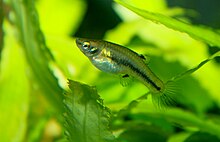Heterandria formosa
| Heterandria formosa | |
|---|---|

| |
| Adult female | |
| Scientific classification | |
| Kingdom: | |
| Phylum: | |
| Class: | |
| Order: | |
| Family: | |
| Genus: | |
| Species: | H. formosa
|
| Binomial name | |
| Heterandria formosa | |
Heterandria formosa (known as the least killifish, mosqu or midget livebearer)[2] is a species of livebearing fish within the family Poeciliidae. This is the same family that includes familiar aquarium fishes such as guppies and mollies. H. formosa is not as commonly kept in aquaria as these species. H. formosa is one of the smallest fish in the world (7th smallest as of 1991[update]),[3] and is the smallest fish found in North America.[4] Despite the common name "least killifish", it belongs to the family Poeciliidae and not to one of the killifish families.
Range and habitat
Heterandria formosa is the only member of its genus to be found in the United States.[5] Its range covers southeastern United States, from South Carolina south to Georgia and Florida, and through the Florida Gulf Coast to Louisiana.[5][6] It is one of the few aquarium fishes to come from North America.
H. formosa lives primarily in vegetated, slow moving or standing freshwater but also occurs in brackish waters.[6]
Description
Heterandria formosa is one of the smallest fish and smallest vertebrates known to science.[5] Males grow to about 2 centimeters (0.8 inches), while females grow a little larger, to about 3 centimeters (1.2 inches).[5][7]
The fish is generally an olive color, with a dark horizontal stripe through the center of the body. There is also a dark spot on the dorsal fin and females also have a dark spot on their anal fin. Like most poeciliids, males' anal fins are modified into a gonopodium that is used for impregnating females during mating.
Diet
Heterandria formosa primarily eats invertebrates such as worms and crustaceans.[6] They also eat plant matter.[6]
Breeding
Like most poeciliids, H. formosa is a livebearer. The male uses his modified anal fin, or gonopodium, to deliver sperm to the female. The fertilized eggs grow within the female until they hatch, and the young are released free swimming. H. formosa has an uncommon breeding strategy even among livebearers. Rather than all the young being released at once, as many as 40 fry are released over a 10 to 14 day period, but occasionally over a longer period.[3][5][7]
Inbreeding depression
The effect of inbreeding on reproductive behavior was studied in H. Formosa.[8] One generation of full-sib mating was found to decrease reproductive performance and likely reproductive success of male progeny. Other traits that displayed inbreeding depression were offspring viability and maturation time of both males and females.
References
- ^ Nicolas Bailly (2010). Bailly N (ed.). "Heterandria formosa Girard, 1859". FishBase. World Register of Marine Species. Retrieved May 29, 2012.
- ^ "Common names of Heterandria formosa". FishBase. Retrieved May 29, 2012.
- ^ a b Baensch, H. (1991). Baensch Aquarium Atlas. pp. 592–593. ISBN 3-88244-050-3.
- ^ Jason C. Chaney & David L. Bechler (2006). "The occurrence and distribution of Heterandria formosa (Teleostei, Poeciliidae) in Lowndes County, Georgia" (PDF). Georgia Journal of Science. 64 (2): 67–75.
- ^ a b c d e Dawes, J. (1995). Livebearing Fishes. pp. 186–187. ISBN 0-7137-2592-3.
- ^ a b c d "Fishbase Heterandria formosa". Retrieved 2008-08-10.
- ^ a b Dawes, J. (2001). Complete Encyclopedia of the Freshwater Aquarium. p. 276. ISBN 1-55297-544-4.
- ^ Ala-Honkola O, Uddström A, Pauli BD, Lindström K (2009). "Strong inbreeding depression in male mating behaviour in a poeciliid fish". J. Evol. Biol. 22 (7): 1396–406. doi:10.1111/j.1420-9101.2009.01765.x. PMID 19486236.
